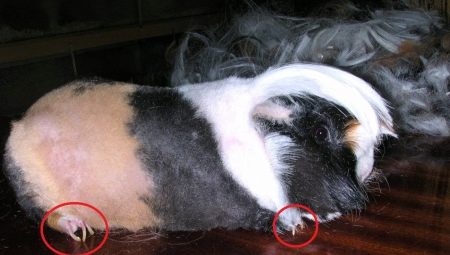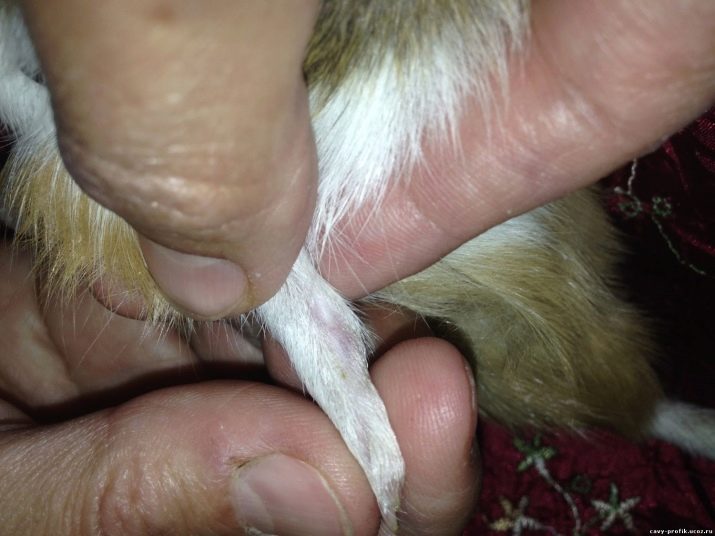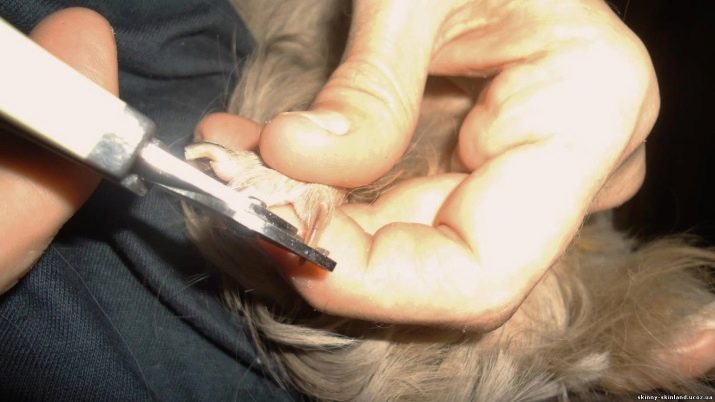How to cut the claws of a guinea pig?

All pets, without exception, require careful care. Particular attention should be paid to the claws. For example, guinea pigs, which are very popular in Russia and abroad, need to be cut regularly. Otherwise, the fluffy pet can get hurt and cause serious harm to its health.

About the animal
The guinea pig is an unpretentious and funny animal that safely adapts to home conditions. Outwardly, it is much larger than a hamster or decorative rat. The rodent has a cylindrical body and sharp teeth. Depending on the breed, guinea pigs are divided into short-haired and long-haired. The color of the pets is striking in its variety: from dark burgundy to silver.
Fluffy "pigs" can be called long-livers. They live for 10-15 years. Much depends on the care.

In particular, trimming the claws of a playful animal is a mandatory procedure that should never be neglected.
When to trim?
In the wild, guinea pigs do not suffer from the problem of regrown claws, as they are naturally worn down. The owner will help pets to cope with claws. For the first time, it is recommended to trim the claws of a fluffy "pig" at an early age, when the pet was just one month old... Naturally, this procedure can be carried out earlier. Everything will depend on the growth of the claws.

Experts recommend cutting the nails 1-2 times a month, when their "transparent" part grows 2-3 mm.
Why should you trim?
The overgrown horny bases on the paws of domestic furry animals can cause irreparable harm to them.In particular, the claws of animals begin to harden and acquire an irregular shape (twist into "spirals"). This can lead to the following troubles:
- deformities of the fingers;
- back problems;
- rotation of claws;
- the development of pododermatitis - an unpleasant disease occurs due to dirt getting under the grown claws;
- injury to the pads of the fingers.

The regrown claws interfere with the movement of the guinea pig. The animal stops moving in the proper volume, which leads to obesity, and subsequently to the death of the pet. In addition, long sharp claws will scratch various surfaces on which the animal will move.
Note that there are blood vessels in the claws of the playful "piglet", therefore it is necessary to cut the horny bases extremely carefully... Your pet does not need to go to a veterinarian to trim its claws. This procedure can be carried out at home.

What do you need?
Preparing to trim your nails involves the following tools.
- Nail clipper, nail clippers or electric sharpener. The last tool can be considered the safest.
- Special styptic powder... You can find it at shops that stock shaving supplies. It will help stop bleeding if you accidentally hit a vessel while clipping the claws. If powder is not available, use chlorhexidine solution.
- Terry towel... It should be soft and voluminous.
- A small nail file. With its help, irregularities are removed after cutting the claws of a guinea pig.




Note that it is better not to use nail scissors for cutting the nails of a pet. The fact is that they will not be able to instantly shorten the tip, which will complicate the procedure.
How to cut?
There are 14 fingers on the paws of guinea pigs: 4 in front and 3 in the back. Experienced veterinarians advise leaving the claws slightly longer on the front toes than on the back.
It is best to trim your pet's claws after sleeping. At this time, he is calm and inactive.

The basic rules of the process are accuracy and attentiveness. In order for the haircut to be painless and quick, pay attention to the algorithm of the procedure for clipping the claws of a fluffy "pig".
- We take the pet out of the cage and calm him down with gentle strokes.
- We wrap the guinea pig in a towel and place it with its back to us, fix its head with our fingers.
- We extend the foot to the "light" and determine the location of the blood vessel.
- We take the pliers and with a sharp movement we shorten the transparent edge of the claw obliquely.
- We perform similar manipulations with all the claws of the animal.
- After each circumcision, we treat the pet with a treat.
- If you do hit a blood vessel, use hemostatic powder promptly. As soon as the bleeding stops, gently remove the remainder of the product. Otherwise, the animal may lick it.
- At the final stage of the procedure, remove all the unevenness of the claws with a file.



Change the litter to a fresh one before sending the animal into the cage after clipping. Otherwise, dirt can clog under the trimmed claws, which will lead to an inflammatory process.
Note that it is most convenient to carry out this procedure in tandem with someone from the household - one holds, and the other cuts.

Useful Tips
The recommendations presented will help you to facilitate the cutting process.
- Start cutting from the front claws, gradually moving to the back.
- If the guinea pig is very nervous, take a short break or stop the process altogether.
- The sound of water or a tasty treat (a slice of pumpkin or celery) can help distract the animal.
- The animal may start biting. In this case, a muzzle designed for miniature dogs will help you.
- Carry out "manicure" for your pet in bright light.
- A towel or sheet will help keep the rodent trying to escape.
Note that if you still doubt your own abilities, then it is best to take your pet to an experienced specialist. The veterinarian can easily cut the claws as quickly and painlessly as possible.

Preventive measures
We have already said that in greenhouse conditions, a guinea pig cannot grind its claws naturally. But still, there are measures to combat excessive regrowth of horny bases. So, you need:
- purchase special scratching posts at a pet store;
- put a piece of brick or other "rough" stone in the cage;
- if the size of the "dwelling" of the rodent allows, then you can build a pyramid of solid materials.
Note that all devices for grinding the claws that you put in the guinea pig's cage must be checked for strength. Otherwise, a fluffy pet can get injured, which will lead to sad consequences.

How to trim your guinea pig's nails, see below.








